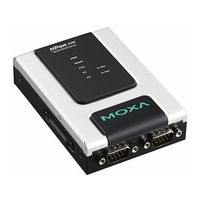Moxa Technologies NPort 6150-T Manuals
Manuals and User Guides for Moxa Technologies NPort 6150-T. We have 2 Moxa Technologies NPort 6150-T manuals available for free PDF download: User Manual
Moxa Technologies NPort 6150-T User Manual (208 pages)
Brand: Moxa Technologies
|
Category: Server
|
Size: 17 MB
Table of Contents
-
Overview7
-
Panel Layout11
-
Nport 645012
-
System Log21
-
Web Console24
-
Arp25
-
Overview32
-
RFC2217 Mode34
-
UDP Mode35
-
SSH Mode37
-
Reverse SSH38
-
What Is Ipv647
-
Ipv6 Gateway48
-
What Is RIP49
-
What Is STP55
-
STP Example58
-
RFC2217 Mode69
-
UDP Mode76
-
Ssh84
-
RAW PRN Mode87
-
LPD PRN Mode88
-
PPP Mode88
-
PPPD Mode89
-
SLIP Mode90
-
SLIPD Mode91
-
Dynamic Mode91
-
User Table96
-
Host Table100
-
Firmware Upgrade101
-
Backup/Restore101
-
Pre-Shared Key101
-
User Account106
-
SNMP Agent109
-
Console Setting111
-
Serial Status115
-
System Status116
-
Network Module118
-
Serial Data Log119
-
Event Settings121
-
DCD Changed122
-
DSR Changed123
-
Email Alert123
-
SNMP Trap124
-
Common Settings125
-
Ping125
-
Change Password125
-
Restart126
-
Restart System126
-
Restart Ports126
-
Logout127
-
Overview128
-
Upgrade Firmware155
-
Web Console156
-
Other Options157
-
Basic Procedures158
-
Hardware Setup158
-
Basic Procedures160
-
Hardware Setup160
-
Introduction166
-
Overview180
-
Example Program182
-
Ethernet Cables184
-
Rfc2217189
-
Moxa-NP6000-MIB194
-
RADIUS Server199
-
What Is RADIUS199
-
Definition199
Advertisement
Moxa Technologies NPort 6150-T User Manual (184 pages)
NPort 6000 Series
Brand: Moxa Technologies
|
Category: Server
|
Size: 20 MB
Table of Contents
-
-
Panel Layout21
-
Nport 645021
-
-
-
Overview38
-
-
SSH Mode44
-
-
Reverse SSH45
-
-
-
-
UDP Mode82
-
-
RAW PRN Mode93
-
LPD PRN Mode94
-
-
-
PPP Mode94
-
PPPD Mode95
-
SLIP Mode96
-
SLIPD Mode96
-
Dynamic Mode97
-
-
-
Basic Settings104
-
Server Settings104
-
Time Settings104
-
-
Host Table106
-
Firmware Upgrade106
-
Backup/Restore107
-
Pre-Shared Key107
-
-
Certificate108
-
-
-
-
User Account112
-
SNMP Agent116
-
Console Setting117
-
-
-
-
Serial Status121
-
System Status123
-
Network Module125
-
Auto Refresh125
-
Serial Data Log126
-
System Log126
-
-
-
Event Settings128
-
Email Alert130
-
SNMP Trap131
-
-
Common Settings133
-
Ping133
-
-
Change Password133
-
Restart134
-
Restart System134
-
Restart Ports134
-
-
Logout135
-
-
-
Overview137
-
-
Rfc2217
165 -
RADIUS Server
176
Advertisement
Related Products
- Moxa Technologies 6150
- Moxa Technologies NPort 6100-G2 Series
- Moxa Technologies NPort 6150-G2
- Moxa Technologies NPort 6150-G2-T
- Moxa Technologies 6450
- Moxa Technologies 6250
- Moxa Technologies NPort 6650-16-48V
- Moxa NPort 6250-M-SC
- Moxa Technologies NPort 6610-8-48V
- Moxa Technologies NPort 6650-16-HV-T

